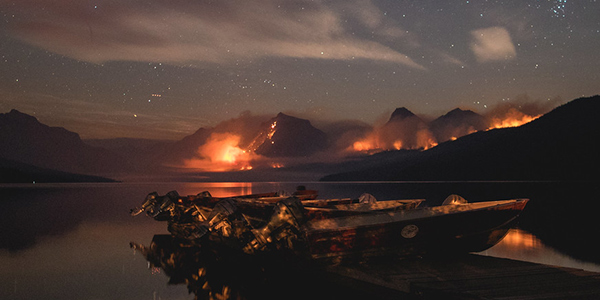A U.S. Senate hearing Tuesday addressed the issue of fighting wildfires in the midst of the coronavirus pandemic, a widespread concern in the West this year, including in California, where utility-sparked wildfires and public safety power shutoffs wreaked havoc in years before the virus spread.
“This summer fire season is shaping up to be as severe as any,” said Sen. Lisa Murkowski (R-Alaska), chair of the Senate’s Energy and Natural Resources Committee. “As fire activity increases, we can expect over 20,000 firefighters to be mobilized by the [U.S.] Forest Service, Interior [Department] and their state, tribal, local and volunteer cooperators.
“At a moment’s notice, fire personnel will be traveling by airplane and vehicle across state borders,” Murkowski said. “Large concentrations of firefighters, support specialists and private service contractors will be assigned to incident command posts — fire camps — where they will eat, rest and stage equipment and supplies. What was operationally routine before may be exactly the kinds of activities that now risk spreading the coronavirus around the fire services.”
The hearing took place in a sparsely populated meeting room where Senate staff members wore masks and kept their distance from each other, and panelists testified by video.
John Phipps, the deputy chief for state and private forestry at the U.S. Forest Service, outlined steps being taken to combat fires while keeping firefighters from spreading infection. He said this summer is expected to be an especially bad wildfire season, requiring new approaches, including an increase in the number of firefighting aircraft.
“Based on long-term weather forecasts and expected dry conditions, 2020 is projected to be a higher-than-average year for wildland fire,” Phipps said. “Aggressive initial attack, supported by airtankers and helicopters, will be used wherever possible to extinguish wildfires quickly and minimize the need to bring large numbers of firefighters together.”
Firefighters will work in small units rather than gathering in large fire camps, he said, and will be screened for COVID-19 symptoms.
“Consistent and continual monitoring of personnel will be a crucial step in preventing the movement of potentially infected individuals and the spread of COVID-19,” Phipps said. “A ‘module as one’ approach is being used for crews and modules to insulate as one unit and reduce exposure to the public and other crews.”
Amanda Kaster, acting deputy assistant secretary for land and minerals management at the U.S. Department of the Interior, said Bureau of Land Management firefighters will work as “family units to protect people, property and themselves.”
With a lower-than-average snowpack in the mountains and faster-than-average snowmelt, Northern California and parts of Oregon face a heightened fire potential, she said.
Fire Season Arrives Early
Already this year, the BLM has sent smokejumpers to Colorado, Nevada and Utah in response to wildfires, Kaster said. Firefighters in New Mexico and Arizona have responded to several incidents, and crews from Montana were sent to Arizona twice, including to national forest land.
“So far in 2020, we are seeing increased levels of wildfire activity in the Great Basin, [Southwestern] and Rocky Mountain geographic areas,” Kaster said. “Based on the most recent seasonal outlook compiled by the National Interagency Fire Center’s Predictive Services Program, we can expect potential for above-normal fire activity in 2020.”
Norm McDonald, director of fire and aviation for the Alaska Division of Forestry, testified remotely from Alaska, where it was 6 a.m. He said Alaskans are concerned about firefighters coming from out-of-state and traveling to small remote communities to fight fires and potentially spreading the coronavirus.
“In Alaska, all incoming personnel are being asked to take a COVID-19 test upon arrival,” McDonald said. “Testing occurs at either of the two major jetports upon arrival, and results are available in 24 to 48 hours. The incoming staff are asked to quarantine at their billets until test results are provided.
“This service will also assist with any COVID-19 cases in the fire ranks and will transport, care for, isolate, house and feed any firefighters that come down with COVID-19 while on assignment in Alaska,” he said. “This is a unique arrangement, but it will help to allow teams to stay focused on what they know best, fighting fire, while third-party medical units care for staff infected with COVID-19.”





